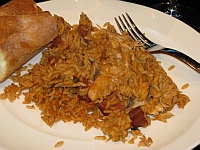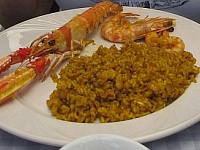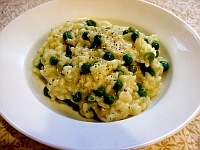Jambalaya is a family of Louisiana dishes made of rice, stock, meats and vegetables, seasoned with Creole Seasoning. Some recipes involve tomatoes and tomato sauce (New Orleans Creole-style "red" jambalaya), others use only chicken or beef stock and no tomatoes (Cajun-style "brown" jambalaya).
There is a close cousin in Spain called paella. Jambalaya originated from New Orleans, as an attempt by the Spanish to cook Spanish seafood paella in the New World, when they took over la Louisiane française following the Seven Years' War. Saffron, an essential ingredient of paella, was not readily available due to import costs, therefore tomatoes became the substitute for saffron. Over time, French influence took over in New Orleans, and spices from the Caribbean changed this New World paella into a unique dish.In making Creole Jambalaya, meat, usually chicken and andouille or smoked sausage, is browned in a sauce pan, followed by vegetables, tomatoes and seafood. Rice and stock are added in equal proportions, the mixture is brought to a boil and left to simmer for 20 to 60 minutes.
Cajun Jambalaya comes from the Cajun Country (southern and southwestern Louisiana) and contains no tomatoes. The meat is browned in a cast-iron pot and the bits of meat that stick to the bottom of the pot give Cajun jambalaya its brown color. A little vegetable oil is added if there was not enough fat in the pot already. The trinity (onions, celery, and green bell pepper) is added and sautéed until soft. Stock and seasonings are added in the next step, and then the meats are returned to the pot. This mixture is then simmered, covered, for at least one hour. At the end, the mixture is brought to a boil and rice is added to the pot. It is then covered and left to simmer over very low heat for at least 1/2 hour without stirring.
The type of rice typically used in Jambalaya is long-grain.
A popular often heard theory tries to explain the origin of the word "jambalaya" as stemming from the Spanish and French words for ham (jamón and jambon, respectively). However, it seems much more likely that the name is simply derived from the word jambalaia, which means rice pilaf in the Provençal dialect spoken in southern France, Monaco, and parts of Spain and Italy.
Anoter dish that probably contributed to the evolution of Jambalaya is Jollof Rice from West Africa. It is thought to have originated in The Gambia and later spread to the whole of West Africa, especially Nigeria and Ghana. The basic ingredients are rice, tomatoes and tomato paste, onion, salt, red pepper and nearly any kind of meat (chicken, beef, bush meat, fish). We remember Jollof Rice from Nigeria made with ginger, garlic, curry powder, chile, thyme and bay leaf.
Paella is a rice dish from eastern Spain (Catalunya) made of vegetables, tomato, seafood or meat, seasoned with saffron. The name Paella is a Calatan word for "pan".
Rice was introduced to Spain by the Moors during the time of Al-Andalus (Muslim-ruled Spain). The Moors were Muslims of black, Berber, and Arab descent from North Africa, who conquered most of modern-day Spain and Portugal in 711 A.D. and ruled it for nearly 800 years until 1492 when the last Emirate (the Emirate of Granada) fell. The real origins of paella probably date to these times when the Moors ruled Spain. The Moors cooked various forms of the pilaf (or palau), which in turn has its origins to the very first culinary uses of rice in ancient Persia in the 5th century B.C. The Pilaf spread throughout the Middle East, Turkey and Central Asia, and was the likely predecessor of Paella in Muslim-ruled Spain.
Paella, in turn, is considered to be the direct ancestor of the Creole Jambalaya.
18th century Valencians cooked an early version of paella consisting of rice, beans, meat and seafood. The present form of Paella first appeared in 1840 in Valencia. Today, Valencian paella (Paella Valenciana) is made with short-grain white rice, chicken, rabbit, sometimes snails or duck, beans, artichoke, tomatoes, rosemary, sweet paprika, saffron, garlic, salt, olive oil and water. Seafood paella (Paella Marinera) is made throughout the Mediterranean coast of northeast Spain. Mussles, shrimp and langoustines are used instead of meat and beans.
Properly made paella is not at all creamy or saucy like risotto, but more glistening, almost dry. This comes from the particular variety of short-grain rice that is used. The traditional varieties are from the Calasparra region around the Province of Murcia. "Bomba" is the is the best quality rice grown there. The one marked as just "Calasparra" is not as highly prized, but it is quite a bit less expensive. If Bomba rice is not available, Calasparra rice is a good substitute, and if that is not available Italian short-grain Arborio rice can be used. However, the Bomba variety is fatter than the other ones and thus absorbs considerably more liquid. Therefore, using Bomba rice will result in a properly cooked dry paella, while Arborio and Calasparra rice will give it a creamier character, more like a risotto. Using Calasparra rice calls for a ratio of 2 parts liquid to 1 part rice. Bomba, being more absorbent, calls for a ratio of 3:1.
Risotto, unlike Paella and Jambalaya, evolved through a completely different avenue. Rice was introduced to Italy by Venetian traders in the 15th century, via merchant ships sailing to and from SE Asia. Rice was adopted quickly and the principal rice-growing area became the northern part of the country (Piedmont, Veneto). A high-starch, round, medium-grain rice is used to make risotto, because it has the ability to absorb liquids and to release starch, which gives risotto its typical creamy texture. The typical varieties are Carnaroli and Vialone Nano rice, to a lesser degree Arborio rice.
Properly cooked risotto is rich and creamy, unlike the paella, but still with some resistance or bite: al dente, and with separate grains. It should be served on flat dishes and it should easily spread out but not have excess watery liquid around the perimeter. It must be eaten at once as it continues to cook in its own heat and can become too dry with the grains too soft.


Jambalaya with chicken and andouille sausage |
Creole Jambalaya |
There are a wide variety of ways to make jambalaya,
with chicken and sausage, or shrimp, or ham, or even duck or alligator.
Here is a recipe from the Gumbo Pages.
Ingredients:
- 1 lb boneless chicken, cubed, OR
- 1 lb shrimp, boiled in Zatarain's and peeled, OR
- 1 lb leftover holiday turkey, cubed, OR
- 1 lb of any kind of poultry or fish, cubed, OR
- Any combination of the above
- 1 lb spicy smoked sausage, andouille or chaurice, sliced on the bias, OR
- 1 lb smoked ham, diced
- 1 large onion, chopped
- 1 bell pepper, chopped
- 3-6 cloves garlic, minced (amount to taste)
- 4 ribs celery, chopped
- 3 small cans tomato paste
- 4 large Creole tomatoes, peeled, seeded and diced, OR
- 1 28-oz can tomatoes
- 8 cups good dark homemade chicken stock
- 2-3 tbsp Creole Seasoning
- Salt to taste
- 4 cups long-grain white rice, uncooked
Preparation:
- In a sauté or frying pan, brown the chicken, sprinkling with Creole Seasoning. Do not brown if using leftover cooked bird, just season the meat. Tear or cut the meat into bite-size pieces.
- Brown the sliced smoked sausage or andouille and pour off fat. In the pot, sauté the onions, garlic, peppers and celery in oil until onions begin to turn transparent.
- In the same pot, while you're sautéing the "trinity", add the tomato paste and let it pincé (brown a little). The browning of the tomato paste is an additional depth of flavor by caramelizing the sugar in the tomato paste.
- Once the vegetables are translucent and the tomato paste achives sort of a red mahogany color, deglaze the pan with the about 2 cups of the stock, scraping the bottom of the pan to mix up any browned bits, and stir until smooth, making sure the sautéed vegetables, paste and stock are combined thoroughly. It should be fairly thick.
- Add the Creole Seasoning, tomatoes and salt to taste. Cook over low-medium heat for about 10 minutes. Add the meat and/or seafood and cook another 10 minutes. If you are using seafood, do not overcook.
- Add the rest of the stock and check seasonings. It is too late to check the seasonings after adding the rice. It is much better for the rice to absorb the seasonings while it is cooking. Stir in the rice, combining thoroughly. Cook for about 20-25 minutes, or until the rice has absorbed all the liquid and is cooked through. The jambalaya has to thicken reach the "right" consistency.
- Serve with salad and French bread.

 |
Seafood Paella (Paella Marinera)
From Denia, Costa Blanca on the Mediterranean coast of Spain. |
Ingredients:
- Rice: at least 1 lb of short-grain rice, exact amount will depend on the size of the pan used. Use Bomba rice, available from Amazon.com, Calasparra or Arborio; do not use long-grain rice for this dish.
- Extra virgin olive oil
- 1 yellow onion, diced
- 2 medium tomatoes, peeled and diced
- 1/2 lb calamar (squid), cleaned and sliced into rings
- 1 1/2 lbs raw mussels in shell (frozen or fresh)
- 1 lb small clams (frozen or fresh)
- 1 1/2 lbs raw shrimp, medium or large - shell on
- 4-6 cups chicken broth
- 1 large pinch Saffron
- 1 cup pickled, roasted pimiento peppers, sliced
- 1 10 oz. pkg frozen peas
- Olive Oil, Salt to Taste
- Special equipment: Paella pan & an outdoor barbecue
Preparation:
- Light coals in the barbecue. When the coals are covered in white ash, cooking can begin.
- Meanwhile, clean the squid and remove the tentacles. Make sure to remove the innards and the "spine" and discard. Then, cut the squid into rings. Try to buy fresh squid whenever possible. If forced to use frozen squid, the squid cannot have batter or coating on it, as that type is used for frying.
- Chop the pepper and onion as directed. Assemble all the ingredients on a table near the BBQ, so that you can stay in the area and monitor the cooking. Place the paella pan on the grate and add enough olive oil to coat the bottom and allow the pan to heat up. When hot enough, sauté the onions and tomatoes in the olive oil. Add olive oil as needed to prevent sticking. Once the onions are translucent, add the squid and cook, stirring often.
- Add the rice, sprinkling in the form of a large cross on the pan. (Have approximately 1 lb of rice on hand for this.) Stir for 2-3 minutes to thoroughly coat the rice with oil and mix with the other ingredients.
- Add saffron threads to the chicken broth and stir. Slowly pour broth into pan until pan contents are covered. Spread ingredients evenly over bottom of pan.
- Arrange mussels around outside edge of pan, pointing up. Place clams and shrimp in pan, distributing them evenly around the pan. Add slices of pepper on top.
- Allow to simmer. Add more broth if necessary. (If fire becomes too hot, raise the pan up, away from the heat.)
- When rice is almost cooked, sprinkle peas over the pan. When rice is cooked, remove from heat and cover with aluminum foil or large tea towel, allowing paella to “rest” for 5 to 10 minutes before serving.
- Slice lemons into wedges and arrange on the edges on the pan. Serve in the pan in the center of the table.
- YIELD: approximately 12 servings.

 |
Risotto Alla Milanese From Antonella Clerici, "La prova del cuoco" cooking show on Rai Uno, 2002 |
Optional ingredients can include sliced porcini mushrooms, making it a Risotto con i Funghi Porcini; asparagus, making it a Risotto con gli Asparagi; tomato sauce, making it a Risotto con il Sugo; sausages, beans and red wine, making it a Risotto al Barolo; or cuttlefish cooked with their ink sacs intact, making it a Risotto al Nero di Seppia. But the classic Milan-style risotto is just this.
Ingredients:
- 5 cups chicken stock or 2 1/2 cups canned broth diluted with 2 1/2 cups water
- 1/8 tsp saffron threads
- 3 tbsp extra virgin olive oil
- 1/3 cup onion, finely chopped
- 3 tbsp prosciutto crudo, finely chopped
- 1 1/2 cup arborio rice, uncooked
- 1/3 cup dry Marsala or white wine
- 1/2 cup Parmigiano-Reggiano cheese, grated
- 1/2 tsp (or to taste) freshly ground pepper
- Salt to taste (optional)
- 2 tbsp unsalted butter
Preparation:
- In a medium saucepan, bring the stock to a simmer and crumble in the saffron threads. Maintain simmer over low heat.
- In a large saucepan, heat the oil over moderate heat. Add the prosciutto and onion and continue to cook cook until the onion is translucent, about 2 minutes
- Now comes the crucial step: Add the rice and stir for another 2 minutes until coated with oil, hot and crackling. Heating the rice grains in this manner will later cause them to crack open when the wine and broth are added, releasing the starch and creating the characteristic creamy texture of the final risotto. Omitting this step is absolutely prohibited.
- Add the wine and cook, stirring, until it evaporates.
- Add 1/2 cup of the stock and cook, stirring constantly, until the rice has absorbed most of the liquid. Gradually add stock, 1/2 cup at a time, cook, stirring constantly, until the rice is almost tender but still slightly crunchy, about 25 minutes.
- Add the cheese and season with salt and pepper. Cook, stirring and adding stock as necessary, 1/4 cup at a time, until the rice is tender but still firm (al-dente) with a creamy sauce, about 6 minutes longer. Stir in butter and serve hot.

back to Radim and Lisa's Well-Travelled Cookbook | email us
Last updated: October 12, 2010